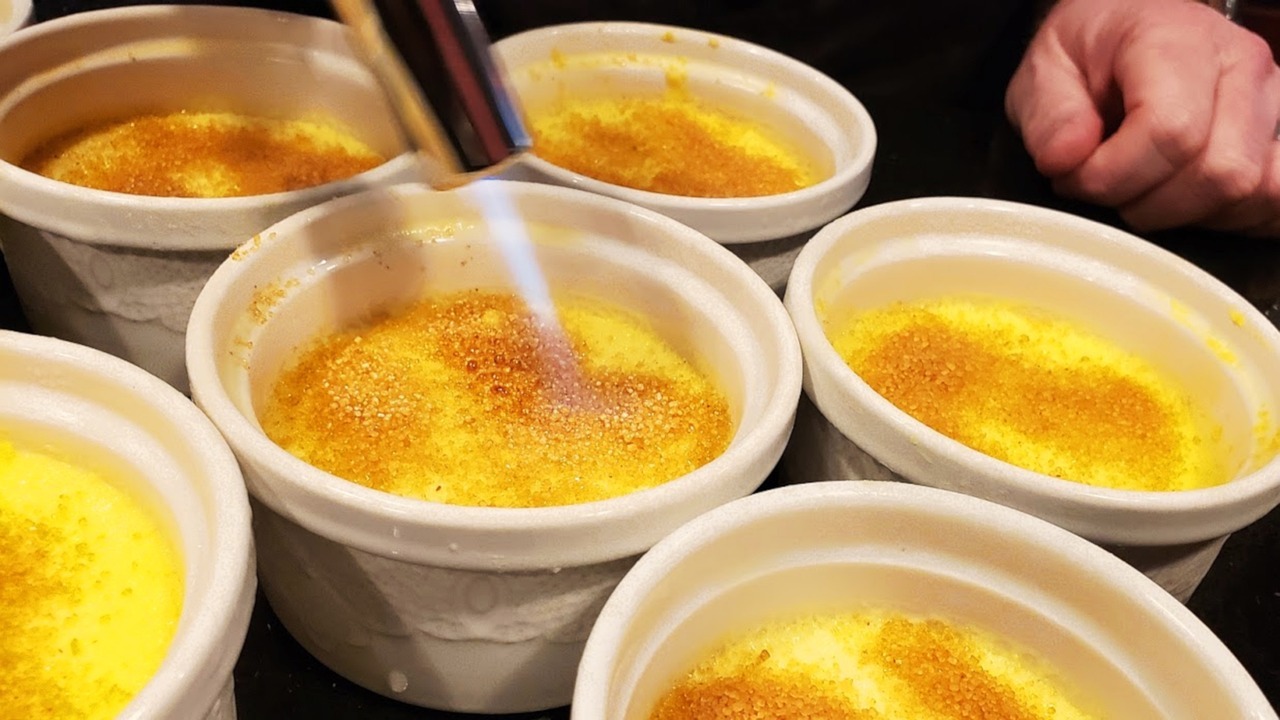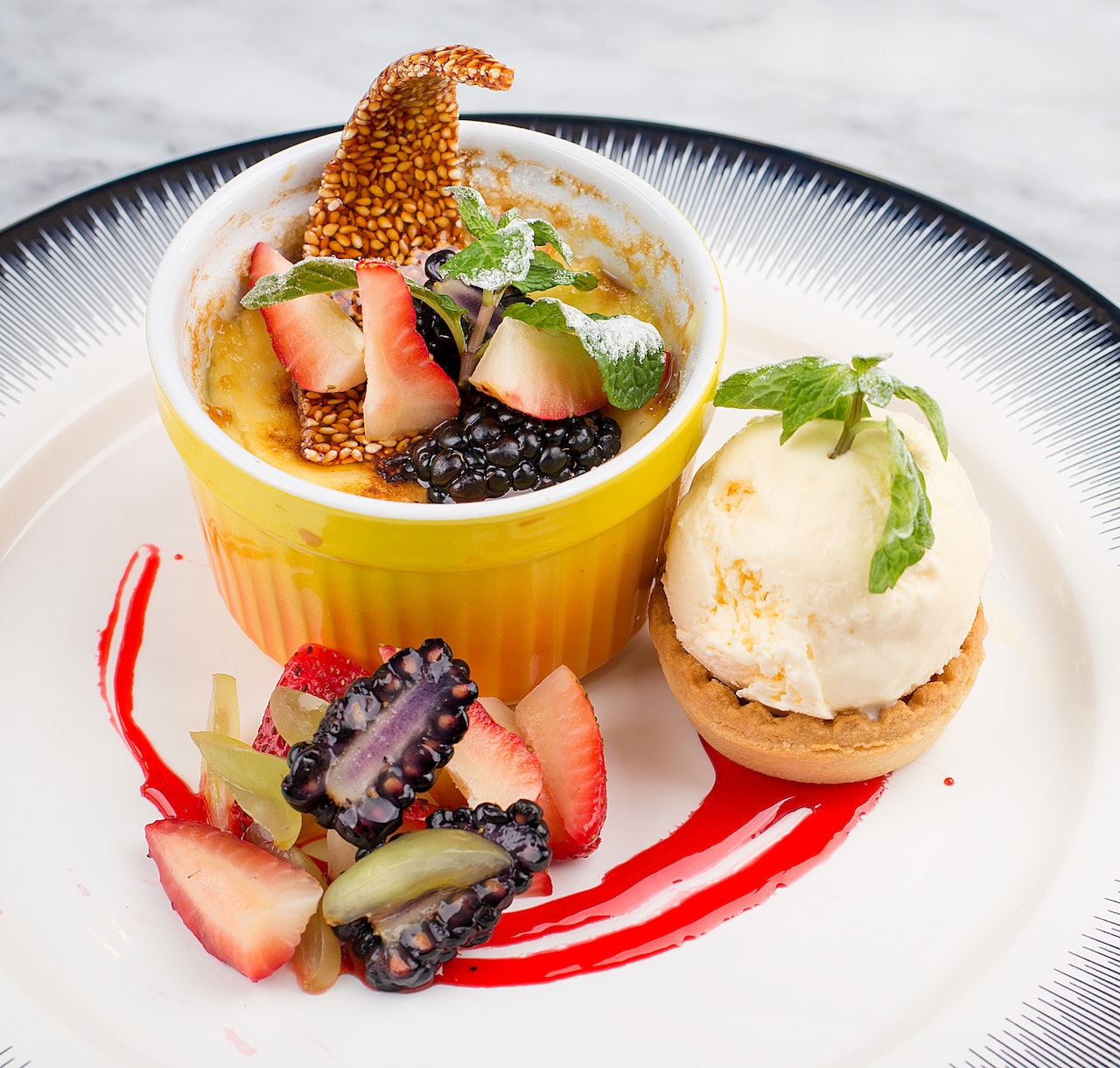Caption: The ideal way to create the topping for the crème brûlée is with a kitchen torch which makes the process both simple and an impressive show for dinner guests. Thus, it has been dubbed as the “brunt cream”.
Many people believe crème brûlée is a French dessert. The name is French, after all. However, it wasn’t until the 19th century that the term crème brûlée gained popularity. Probably merely another variation of a custard dish that circulated through the Middle Ages is crème brûlée.
It’s however unclear where crème brûlée first appeared. The countries Spain, England, and France laid their claims and assert that it was in their country where crème brûlée first appeared.
A cook at the Palace of Versailles named Francois Massialot published the first recipe for crème brûlée in the 1691 edition of the French cookbook Le Cuisinier Royal et Bourgeois. That version had a crust made of caramelized sugar and was a sweet custard made with milk and egg yolks. It resembles contemporary versions.
In Cambridge, England’s Trinity College, the dish was referred to as “burnt cream.” A hot iron was used to burn the college crest into sugar on top of a custard. It could have existed before Massialot’s cookbook, as source claims that Trinity served it for the first time in 1630.
The Catalans is hot on the heals of their English counterparts saying the dessert is their own original crème catalana which is a thick custard topping with caramelized sugar, it is frequently flavored with cinnamon and lemon or orange zest. The 18th century saw the first mention of the Catalan version. It is also known as Crema de Sant Josep, after the Virgin Mary’s husband, Saint Joseph. Saint Joseph’s Day is observed on March 19 in Spain and several other countries around Europe. On this day, crema catalana is a customary dessert.
There are reports too, of Thomas Jefferson presenting a comparable dessert at the White House 1, and a recipe can even be found in the 1942 edition of Fannie Merritt Farmer’s The Boston Cooking School Cookbook.
The crème brûlée gained enormous popularity in the 1980s and was dubbed “a symbol of that decade’s self-indulgence and the darling of the restaurant boom”; Sirio Maccioni’s Le Cirque restaurant in New York is likely to blame for its rise to fame. It was, according to him, “the most famous and by far the most popular dessert in restaurants from Paris to Peoria.”
Typically, crème brûlée is served in little ramekins. Caramel can either be made directly on top of the custard shortly before serving, or it can be cooked separately and added just before serving. To achieve this, sugar is sprinkled on top of the custard and caramelized using a blowtorch or a salamander broiler. It is normally served at room temperature.
The biggest crème brûlée ever made reached a maximum circumference of 26 feet, weighed 1,600 pounds, and contained an estimated two million calories. (A 20-foot-diameter crème brulee baked in California in 1999 previously held the record). It was made by students of the Le Cordon Bleu Program at the Orlando Culinary Academy, Orlando, Florida, USA on February 12, 2005.The dessert’s ingredients included 4,000 eggs, 19 gallons of milk, 1 gallon of vanilla extract, 115 liters of cream, and 125 pounds of sugar.
Secret of the “burnt cream”
A layer of solidified caramelized sugar is placed on top of a rich custard foundation comprised of heavy cream, egg yolks, sugar, and vanilla, creating a texturally interesting contrast. Traditional custard foundation flavors include vanilla, although additional flavors including fruit, chocolate, and orange liqueur are also acceptable.
Sprinkled on top of the custard is sugar that has been caramelized in the oven or using a kitchen blowtorch. The heat from the caramelizing process tends to reheat the custard, leaving a chilly core, therefore this dish is typically served slightly cooled. A liquor can be poured on top of the caramelized sugar crust before lighting it on fire.
Crème brûlée is cooked in a pan of water and refrigerated for many hours in France. The contrast between the smooth, chilly custard and the crunchy, hot topping is maintained by first sprinkling sugar on top of the custard, caramelizing it with a kitchen blow torch, and serving it fast.
This dessert comes in both highly sweet and more savory variations. While other forms of the custard call for the addition of vanilla flavoring, the French frequently add a lot of sugar. There are several variants in custard flavors, though:
Popular variations include adding orange or lemon zest to a sweeter custard. Some recipes call for the inclusion of vanilla bean, cocoa, or even coconut extract. An occasional pleasant addition to this meal is fresh fruit. The thick custard is wonderful when paired with raspberries or blueberries.
Liqueurs can be added too. Before baking, stir in 1 to 2 teaspoons of Irish Cream, Grand Marnier, Amaretto, or Kahlua. Sometimes the custard is topped with bittersweet grated chocolate before the sugar topping is applied.
Variations on top
The crème brûlée recipe is a classic and timeless one in many aspects. This well-liked dish can be altered in a variety of ways, from its precursor, the sweet custards of the Middle Ages, through the varieties of today.
A crème brûlée is, in essence, a smooth, creamy custard that has been covered with caramelized sugar. The kind of sugar or other topping used and how it is caramelized can change, though.
For dramatic effect, liquor is occasionally added to the topping and set on fire. Instead of using a blowtorch, you can set the custards on a baking sheet and broil the sugar coating for a few minutes.
For the topping, brown sugar may be used in favor of granulated sugar.
To torch or not to torch
The topping is best made using a kitchen torch, which makes the procedure quick and entertaining for dinner guests (though we advise rehearsing before doing it in front of an audience). Till the sugar melts to an even caramel crunch, keep the torch approximately 2 to 3 inches away from the surface.
If you don’t have a kitchen torch, you may either broil or grill the ramekins to caramelize the topping. This is not ideal, so be aware that you need keep a careful check on the desserts while they broil since they may easily turn from golden brown to burned.
Crème or the Flan
The best and most popular custard desserts nowadays are flan and crème brûlée. Some people mistakenly believe that these two are the same, yet there are really many distinctions between the two.
While crème brûlée is also created with vanilla extracts, sugar, egg yolks, and cream, flans are made with cream or milk, vanilla, and egg yolks. When it comes to preparation, the proportions of the same elements differ. Additionally, the toppings and coatings vary.
The toppings are where a flan and a crème brûlée makes the most difference. For instance, crème brûlée has a firm caramel coating formed by torching or broiling the sugar on top, but a flan has a soft caramel top layer. However, depending on the ethnic origin of the dish, these toppings change. The greatest crème brûlée is served at the local French restaurant The Brentwood, which serves authentic French fare.
The issue of texture is another. There is a fine caramel coating on crème brûlée. It is cooked in a custard-like foundation with egg yolks, additional vanilla, and cream as its main ingredients. It is chilled before sugar is sprinkled on top and a torch is used to broil it, giving it a caramelized texture.
Egg yolks, vanilla, and cream or milk are used to make flans, which give the dish a coating of soft caramel. Its background has a significant impact on the texture. For instance, a Latin flan has a milky caramel syrup, but a European flan includes a topping of caramelized sugar.
Making the custard smooth
Starting with the custard and finishing with the sugar in two batches ensures a flawless surface for the sugar to be brûléed.
Your custard will have some froth on top after you have combined the cream and eggs. Once the custard has cooked, if you don’t skim the froth off the top, all those bubbles will explode and give your creme brulee a rough texture.
After straining the custard but before putting it into ramekins, skim the froth from the top.
Custard is done
The custard is done when you touch the side of the ramekin, it jiggles or wobbles consistently from edge to edge. It is not ripe if the sides jiggle and the middle sloshes somewhat. Another is when the custard slightly spring back after you softly touch its core and leave most of your finger’s surface unblemished. (It’s okay if you touch it too firmly and break through the surface; the custard will still look creamy below and set as it cools.) The top should appear shiny, and the color should be uniform and constant without any brown blotches.
Conclusion
Creme brulee is a delight to eat in all its contrasts. Part of the fun of eating is in delicately cracking the crunchy sugar surface with the edge of your spoon to reveal the soft custard underneath. Each bite will contain custard and a small amount of the crunchy topping as you dig in into the rameskins.
It’s possible that no one will ever discover who created crème brûlée or its origins. But everyone may agree that this mouthwatering dessert ought to be included in international cookbooks. Serve it at your next dinner party. It’s the perfect make-ahead dessert!

